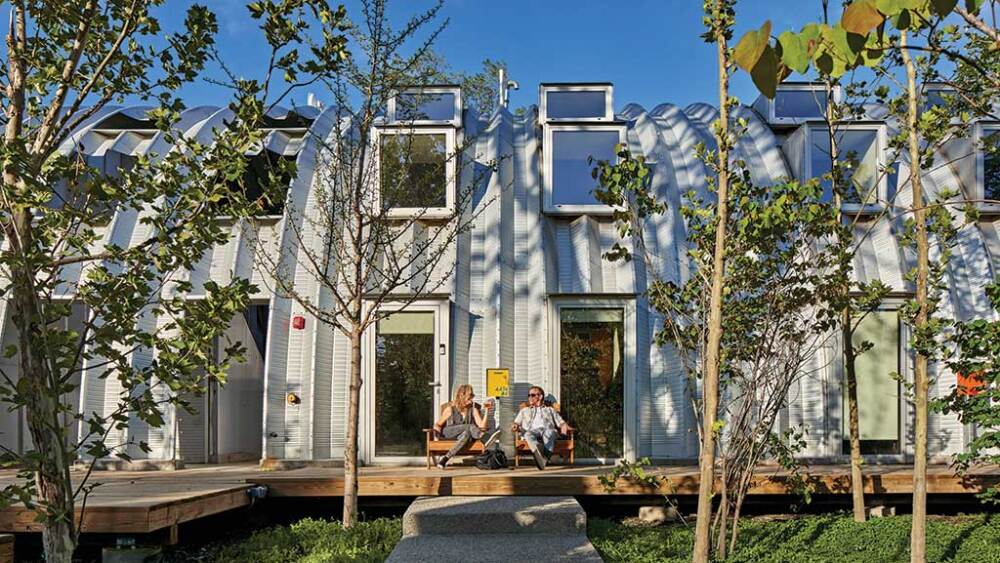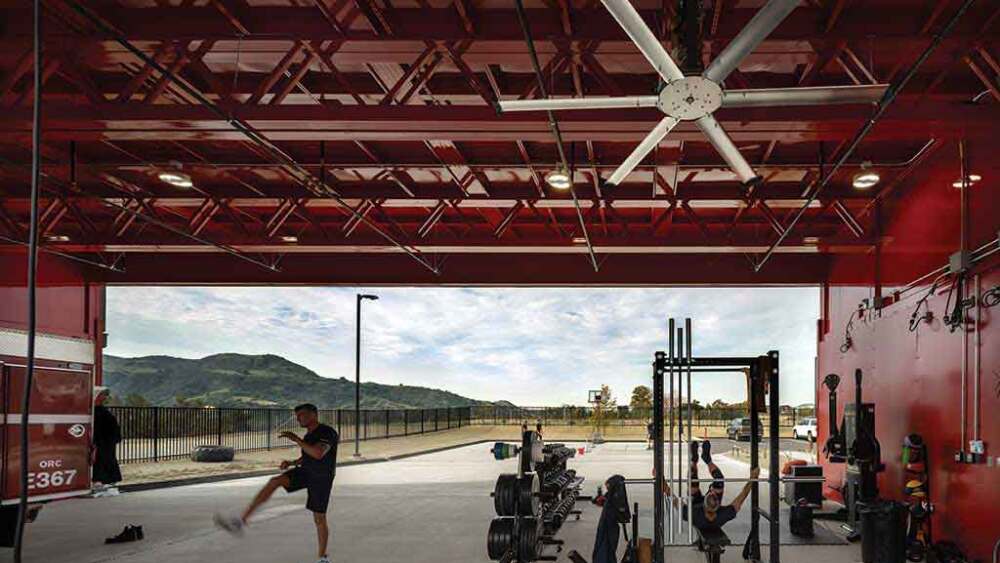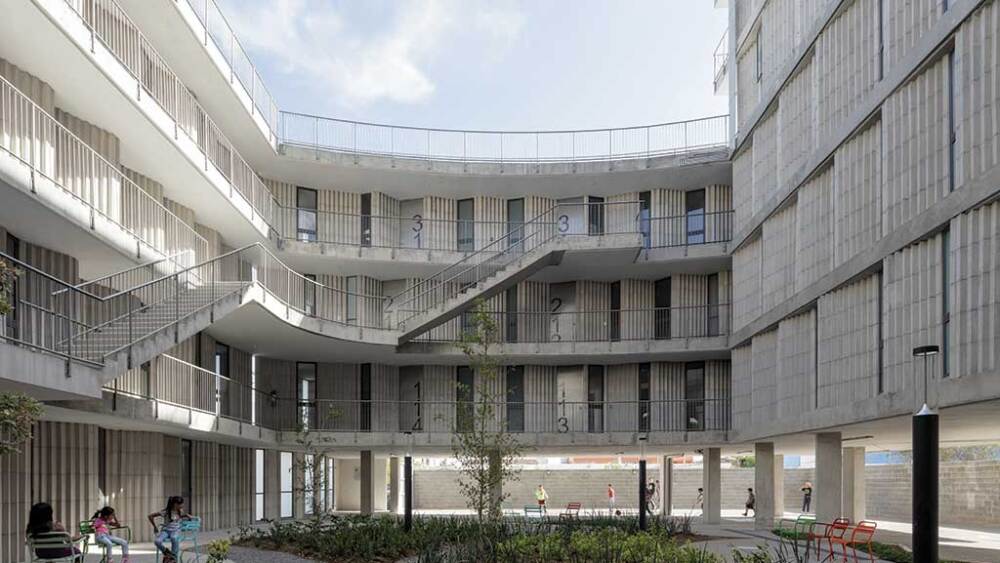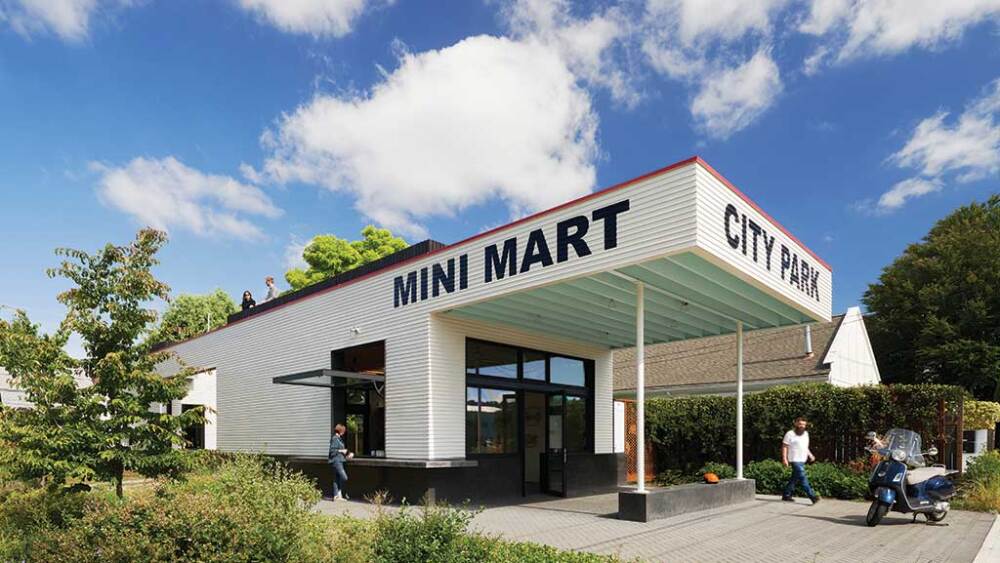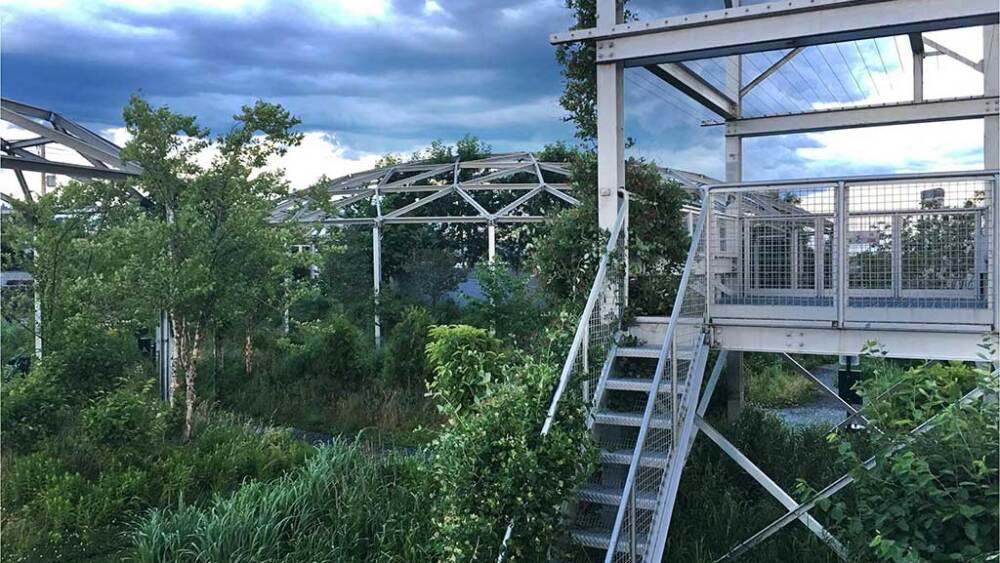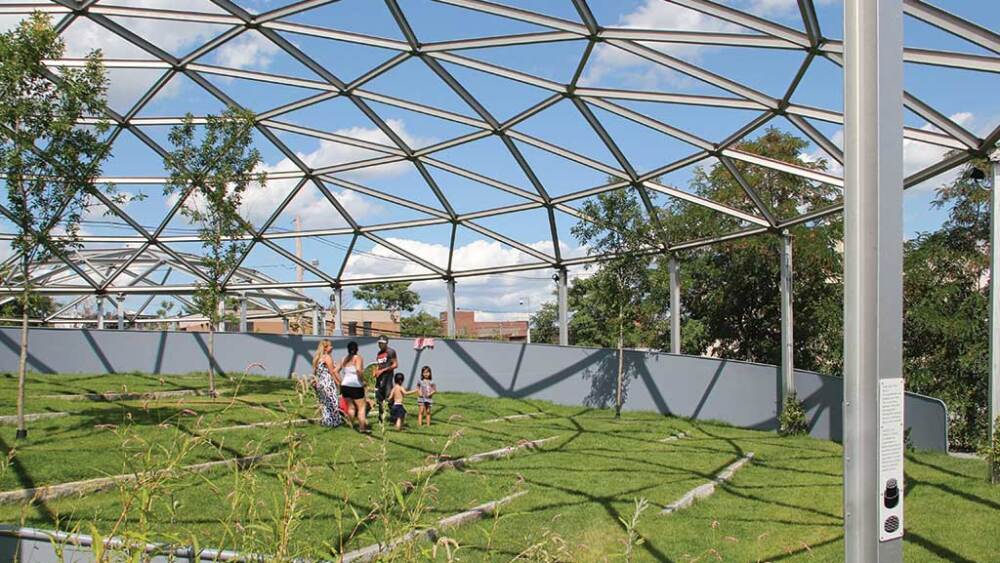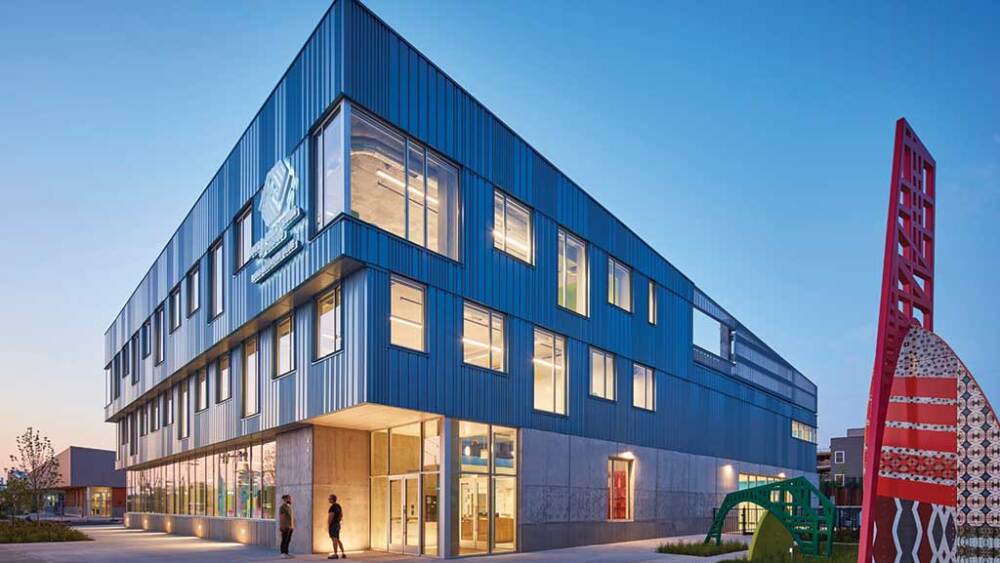Design firms led by Gen X and Gen Y principals are coming into their own in an era of aging cities and industrial parks, rising housing costs, increasing wildfires and floods, continuing urban sprawl, and the lingering dominance of the automobile. The 10 firms profiled here, led by men and women in their 30s and 40s, have responded creatively to these challenges, devising cost-effective approaches to the designs of residences and green spaces, shortening construction times by deploying prefabricated structures, and transforming brownfields for community use.
The following projects include an approach to rescuing neglected public parklands, one patch of ground at a time: a new park that shares space with stockpiles of road salt; eight dwellings tucked into one long Quonset hut; a community arts center on the site of a former gas station; a modular interim fire station designed to ultimately become an environmental learning center, and others.
1. Allen Apartments
Buffalo, New York
At the edge of Buffalo’s Allentown Historic District, small Colonial, Gothic Revival, Italianate, and Queen Anne buildings sit across Main Street from large contemporary structures such as the University at Buffalo’s Jacobs School of Medicine and Biomedical Sciences. At the corner of Allen Street and Main, Mayflower Allen Property asked Los Angeles–based Adam Sokol Architecture Practice (ASAP) to give new life to a 1920s-era, six-unit, two-story apartment building in deep disrepair.
Founded in 2011, ASAP convinced the city’s preservation board to allow demolition of the historic structure while keeping the storefront’s existing tan brick façade. Buffalo’s new Green Code allowed the building to forgo a parking requirement, freeing up room for a three-story addition clad in dark gray metal panels that steps back from Main Street and holds 10 units. At the rear, the building’s angular volumes frame a new courtyard shared by its neighbor, also owned by Mayflower. The Allen Apartments were completed in 2022.
2. Caterpillar
Detroit, Michigan
Seeking a low-cost way to add housing to former industrial land in Detroit’s Core City neighborhood, local developer Prince Concepts turned to the Quonset hut, a prefabricated half-cylinder structure made of corrugated galvanized steel that was created in the 1940s by the U.S. Navy.
Prince first tapped Los Angeles–based EC3 to design True North, eight individual huts that were completed in 2017. Next, Prince turned to local firm Undecorated, founded by Ishtiaq Jabir Rafiuddin in 2017, which worked with manufacturer SteelMaster to customize one long 9,000-square-foot (836 sq m) Quonset hut to hold six apartments and two live-work spaces.
To bring in daylight, the manufacturers cut 12–18 openings per unit, including glazed doors and dormer windows. In each apartment, the sleeping and living room areas flank a plywood service core containing the kitchen, bathroom, laundry, and closet. Outside, a wooden deck wraps the long horizontal building, providing a front porch for socializing. Completed in 2021, Caterpillar is surrounded by 150 newly planted trees.
3. DADA Distrikt
Brno, Czech Republic
In the Czech Republic, one of Europe’s least affordable countries, a group of individuals opted to reduce their housing costs by directly hiring a local architecture firm to convert a former industrial building from the early 1900s into a mixed-use residential complex for themselves. KOGAA, founded in 2015 by Tomas Kozelsky, Alexandra Georgescu, and Viktor Odstrčilík, inserted nine loft apartments and four studio units, as well as office space, but kept the intervention minimal, retaining the four-story facility’s structure, elevator car, and distinctive curved stairwell.
Sited next to Brno’s historic industrial Zbrojovka area, the building is also close to the Svitava River. To reduce stormwater runoff, the design team topped the structure with a vegetated roof that filters rainwater for use in the building’s washrooms and irrigation system. The roof also has space for gatherings, yoga, barbecues, and movie screenings, as well as a raised gardening bed for each dwelling. The DADA Distrikt was completed in 2020.
4. Estación San José
Toluca de Lerdo, State of Mexico, Mexico
In Toluca de Lerdo, the capital city of Mexico’s most densely populated state, Madrid-based FRPO replaced a former parking lot with a new mixed-use concrete structure envisioned as a community hub for the area. Behind a lightweight metallic screen, Estación San José contains several levels of parking, office and working areas, as well as commercial spaces. The rooftop offers a publicly accessible garden with views of the historic San José Cathedral, the Cosmovitral Botanical Garden, and Nevado de Toluca mountain.
Founded in 2005 by Pablo Oriol and Fernando Rodriguez, FRPO negotiated extensively with Mexico’s National Institute of Anthropology and History, the bureau that oversees the country’s historic built environment, to minimize the building’s visual impact on the nearby historic district. The white metal screen not only gives the building a diaphanous presence in the skyline, it also shades the interior, with large cutouts offering more views of the area’s historic sights. Estación San José was completed in 2020.
5. Fire Station 67
Rancho Mission Viejo, California
In response to California’s increasing wildfire threat, the town of Rancho Mission Viejo, the Orange County Fire Authority, and 2G3R teamed up to provide this historic ranching community with an interim fire station. Seattle-based architecture firm
Wittman Estes designed the station as a modular facility, prefabricated off-site from 10 pieces, and clad in fireproof corrugated steel. The modular strategy sped up design, documentation, permitting, and construction: groundbreaking began less than a year after the design process started, and the 4,667-square-foot (434 sq m) facility was done in six months.
The apparatus bay is open to the air, eliminating the expense of a large air exhaust system. The bay doubles as a multi-use space for exercising, gathering, and events. A trellis shades the central courtyard. Founded in 2012 by principals Matt Wittman and Jody Estes—later joined by principal Ashton Wesely—Wittman Estes used a “kit of parts” approach so the building can be easily disassembled, relocated, and reconfigured as needed, with ultimate plans to turn it into an environmental learning center. Fire Station 67 opened in 2022.
6. Las Americas Social Housing
León, Guanajuato, Mexico
To help curtail sprawling development on its urban fringe, the city of León and its housing agency commissioned
Brooklyn-based SO-IL to design a cost-effective, multifamily residential prototype that would appeal to people accustomed to single-family houses. Founded in 2008 by Jing Liu and Florian Idenburg, SO-IL arranged 60 condominiums on six floors that surround two internal courtyards, providing units with cross-ventilation.
To enhance a sense of privacy similar to that of asingle-family house, the designers ensured that no two units would face each other, organizing them along a single-loaded corridor that looks out to the courtyards. Each floor shares patios and outdoor walkways to foster community. Units range from one to three bedrooms. Fins provide shading, and the concrete structure’s high thermal mass moderates temperatures. Most units were sold at below-market rates. Close to schools, shops, parks, and public transit, Las Americas was completed in 2021.
7. Mini Mart City Park
Seattle, Washington
As electric vehicles become more common, so too will abandoned gas stations. Seattle’s Mini Mart City Park suggests one solution: replace them with arts-oriented community centers and parks. Local artist group SuttonBeresCuller purchased a 1920s-era filling station in 2013 to convert into an arts hub. The building proved too small and dilapidated, so Seattle-based GO’C designed a new facility with plenty of references to its predecessor, including a large overhanging roof, hand-painted signage, and divided metal windows. An air-sparge and soil vapor extraction system treats the contaminated site.
Founded in 2012 by Aimée O’Carroll and Jon Gentry, GO’C configured the building with a gallery/community center on one side and a storage/utility room on the other. A courtyard in between hosts movie nights and large-scale installations. Planted with drought-tolerant species, the rooftop also serves as a gathering space. Mini Mart City Park opened in 2022.
8. The PORT at Rock Chapel Marine
Chelsea, Massachusetts
One way to reconnect urban areas to the waterfront is to redevelop industrial sites into other uses. Sometimes, however, the industry is still active. The PORT (Publicly Organized Recreation Territory) at Rock Chapel Marine provides a model for sharing uses between industry and the public.
In 2005, Eastern Minerals acquired an oil tank farm adjacent to its road salt storage facility along the Chelsea Creek, with a promise to the city to fund public amenities in return for its expanded storage capacity. Landing Studio, based in Somerville, Massachusetts, and founded by Dan Adams and Marie Law Adams in 2005, converted the oil tanks into roof trellises and an amphitheater, and barge loading racks were transformed into viewing platforms.
Salt piles during the winter serve as storm surge protection. When stockpiles are low in warmer months, the vacant space will host basketball and community events. Salt dock workers helped with construction and continue to perform maintenance. Design work on the park is ongoing.
9. Rusu-McCartin Boys and Girls Club
Chicago, Illinois
Chicago’s first newly built Boys and Girls Club in a half century opened on the West Side in 2023. Adjacent to the new Chicago Joint Public Safety Training Campus, the Rusu-
McCartin Boys and Girls Club bolsters the kids’ connections with first responders, who sometimes stop by to participate in club activities. Designed by Latent, which was founded in Chicago by Katherine Darnstadt in 2010, the three-story structure emerged after extensive input from local youth and the community.
The building includes plenty of casual places to hang out, as well as a double-height gymnasium, classroom spaces, a teaching kitchen, a meadow, and a rooftop garden planted with local species. Expansive glass at the ground floor showcases the activities within; upper floors have access to plentiful natural light as well. The façade is clad in iridescent blue metal panels that reflect the sun in varying ways over the day and transition to a perforated screen wall at the roof deck.
10. Test Plot, Elysian Park
Los Angeles, California
TERREMOTO, a landscape architecture design studio based in Los Angeles and San Francisco, noted the long-neglected, invasive-species-ridden terrain of LA’s Elysian Park and decided to collaborate on an intervention with Citizens Committee to Save Elysian Park and the local gardening firm Saturate. With the blessing of the city’s department of parks and recreation, TERREMOTO fenced off a 30-foot-diameter circle, the reach of a radial spray. In 2019, volunteers began weeding the spot by hand and planting native species.
Test Plot provides a real-world way to experiment with different methods of planting and weeding to see what works for a given location. Test Plot has since expanded to more than 10 sites across California, several of them in partnership with students in the landscape architecture and urbanism program at the University of Southern California School of Architecture.
TERREMOTO was founded in 2013 by David Godshall and Alain Peauroi, later joined by partners Jenny Jones and Story Wiggins.


